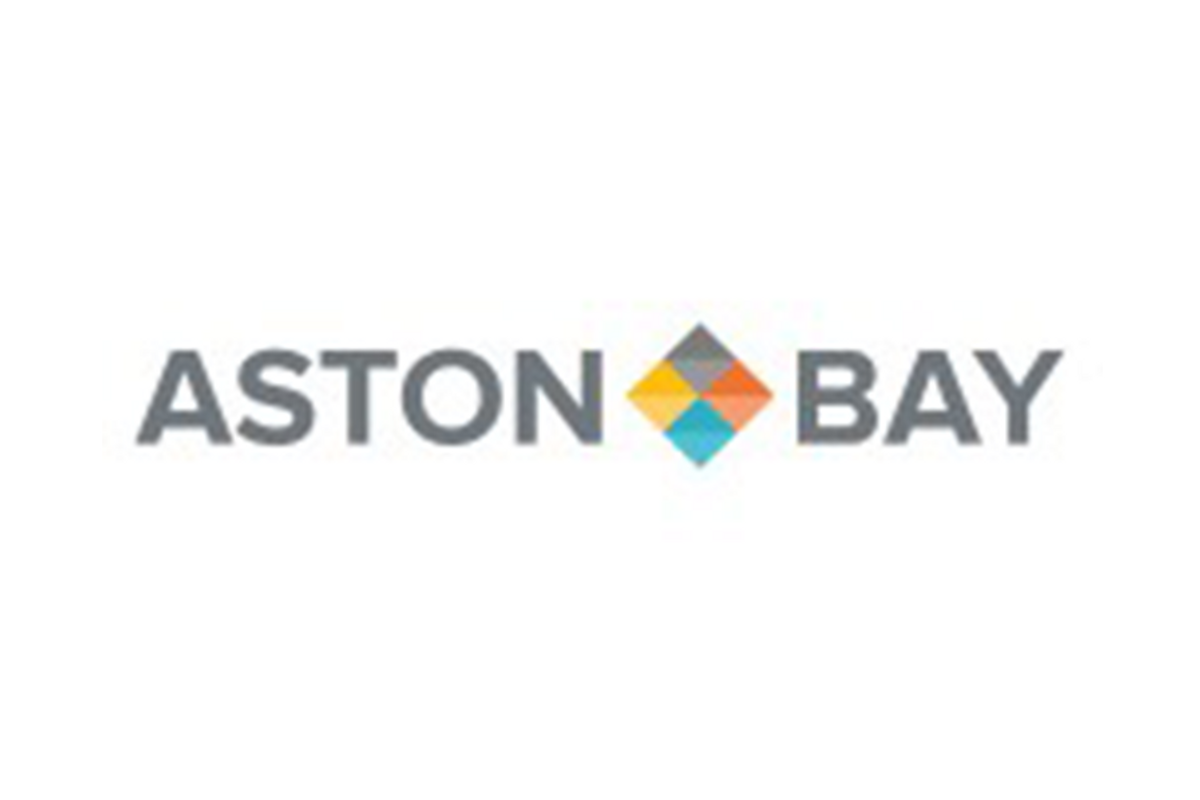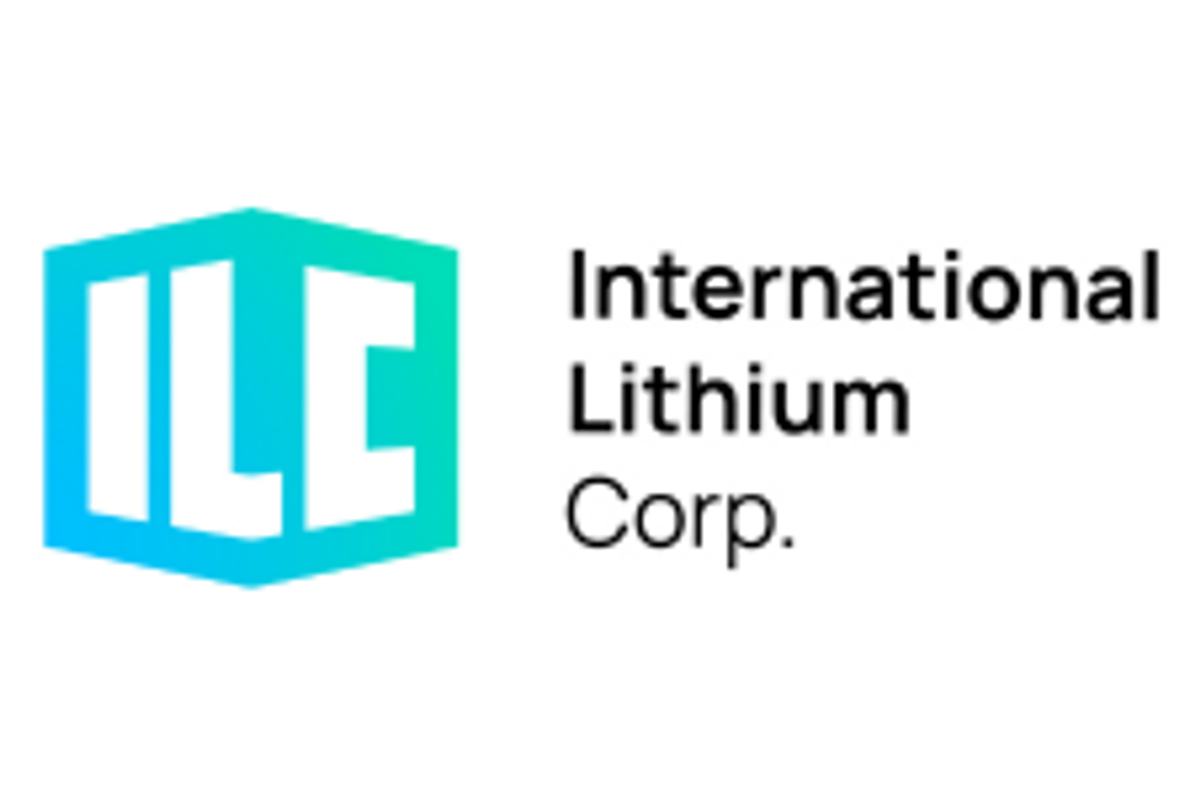
- Diamond drilling of a large gravity target has intersected thick intervals of copper sulfides
- The discovery drill holes show similarities to many of the world's major sediment-hosted copper systems, including the deposits of the Kalahari Copper Belt and Central African Copper Belt
- Total of 45.5m of visual sulfides intersected in drill hole ST23-01 comprising:
- 30.5m of breccia-style visual copper sulfide (dominantly chalcocite) within three zones associated with the shallow copper mineralization of the 4100N Zone between 45m and 86m downhole, and deeper in the same hole,
- 15m of visual breccia and vein-style copper sulfide (dominantly chalcopyrite) between 332m and 347m downhole - the first discovery intersection
- Diamond drill hole ST23-02 has intersected a second and more impressive discovery zone:
- 37m of visual breccia-style copper sulfide (dominantly chalcocite with minor native copper) between 333m and 370m downhole
- The two diamond drill holes are located 680m apart - the continuity of the mineralized horizon and the size of the gravity anomaly (>5km long and up to 1km wide) suggests that drilling has potentially identified a large copper deposit
- Mineralization was intersected in both holes at the top of a modeled gravity anomaly, highlighting the potential effectiveness of the technique for exploration targeting
- Gravity targets similar to that intersected by these initial diamond drill holes cover an extensive area at Storm and remain untested by drilling, supporting the potential for a major, regional-scale copper system
- Diamond drilling continues on high-priority copper targets with first assays expected in the next 4 weeks
- Reverse circulation resource definition drilling is also underway on near-surface copper targets with results from the 2750N and 2200N Zones expected shortly
Aston Bay Holdings Ltd. (TSXV:BAY)(OTCQB:ATBHF) ("Aston Bay" or the "Company") reports significant copper sulfide mineralization intercepts from the initial two diamond drill holes testing a blind gravity target at the Storm Copper Project ("Storm" or the "Project") on Somerset Island, Nunavut, Canada. The program, still underway, is being conducted by American West Metals Limited ("American West"), who are the project operator since entering an option agreement with Aston Bay in March 2021
"Discovery of sedimentary hosted copper has been the true goal for all explorers at Storm, including Aston Bay. I'm delighted to report that, finally, the quest has succeeded, and we have definitive proof of a new sediment hosted copper system," stated Thomas Ullrich, CEO of Aston Bay. "Our geological model has predicted the presence of chalcocite in permeable sedimentary horizons, hidden in the subsurface - this discovery proves it. The copper is there. Not only have we hit a significant mineralized interval, but presence of chalcocite in the latest hole provides a vector to more copper-rich mineralization within this very large gravity anomaly.
"Both initial drill holes have intersected higher-density copper sulfide mineralization at the top of the modeled density anomaly, and at the same stratigraphic horizon. This confirms the presence of hidden sediment hosted copper mineralization as predicted and, importantly, demonstrates that we have a potentially effective targeting tool to find it: the ground gravity surveys yield excellent resolution and depth control, proven with success at the drill bit.
"Airborne and ground gravity surveys have revealed anomalies, both blind and those associated with surface copper mineralization, for over 10km to the west and south of this discovery. This offers tremendous potential for additional discovery. This discovery is analogous to the world-famous copper belts in Africa that contain some of the world's largest and highest grade copper deposits."
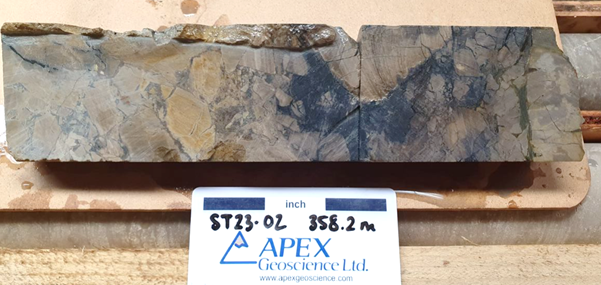
Figure 1: Photo showing example of strong chalcocite (dark grey) breccia fill and veining in drill hole ST23-02 from approximately 358.2m downhole. Chalcocite is a copper sulfide mineral and contains approximately 79.8% copper.
DIAMOND DRILLING HITS THICK AND EXTENSIVE COPPER SYSTEM
Diamond drill holes ST23-01 and ST23-02 have been completed at the Storm Project with both holes intersecting thick intervals of visual copper sulfides. The drill holes were designed to test the outstanding gravity targets that were defined beneath the near-surface mineralization at Storm (see June 9, 2023 Aston Bay news release).
ST23-01 and ST23-02 were completed in key locations below, and to the west of the near-surface, high-grade copper 4100N Zone (Figures 2 and 3). The drill holes have intersected 15m and 37m of visual copper sulfides (respectively) within what is interpreted to be the same mineralized deeper stratigraphic horizon. The copper mineralization consists of chalcocite, chalcopyrite and native copper and is hosted within a vuggy, organic-rich sequence that has a higher density than the surrounding stratigraphy and is interpreted to be the source of the gravity anomaly. This is the first intersection of the higher-copper content mineral chalcocite (79.8% copper) at this stratigraphic depth. Chalcocite is typical in sediment hosted copper deposits, including the deposits of the Kalahari Copper Belt and Central African Copper Belt, and is an important and high-value copper mineral.
Drill hole ST23-01 was also designed to test the northern margin of the copper mineralization within the 4100N Zone. Intersected a total of 30.5m of breccia and vein-style visual copper sulfides within three distinct zones. The sulfides are very similar to the known high-grade mineralization at the 4100N Zone and it remains open to the north.
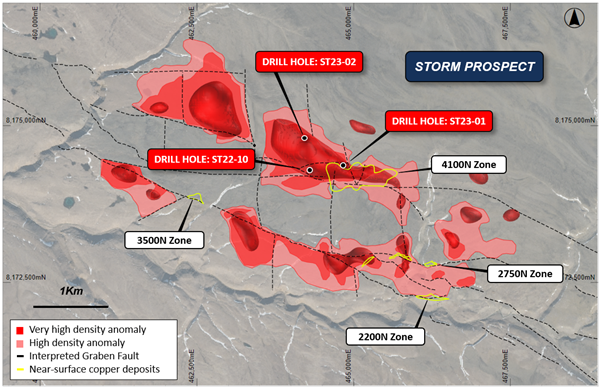
Figure 2: Plan view of the Storm area showing the gravity data interpretation, near-surface mineralization footprint (yellow), major faults, and diamond drill hole locations in this report.
The distinctive mineralized horizon encountered at depth within ST23-01 and ST23-02 is interpreted to correlate with the stronger copper mineralization intersected in 2022 drill hole ST22-10. The holes are located approximately 680m apart and approximately 500m to the north of ST22-10. The large spacing between these drill holes, and scale of the gravity anomalies are strong evidence of a very large, laterally extensive copper system in the Storm Project area.
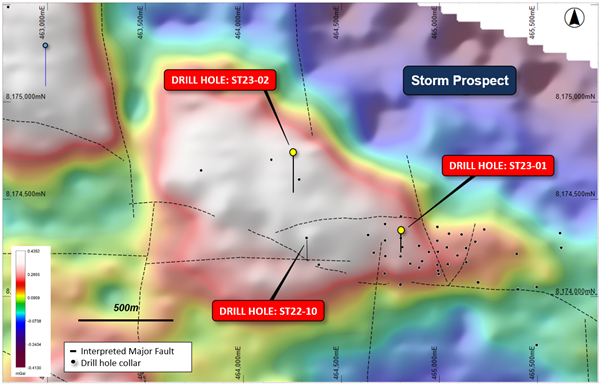
Figure 3: Total bouguer gravity image of the 4100N area, fault architecture and drill hole locations.
Hole ID | Prospect | Easting | Northing | Depth (m) | Azimuth | Inclination |
ST23-01 | 4100N | 464805 | 8174335 | 416 | 180 | -75 |
ST23-02 | EXPL. | 464255 | 8174741 | 602 | 180 | -70 |
Table 1: 2023 diamond drilling program details.
Visual estimates of mineral abundance should never be considered a proxy or substitute for laboratory analyses where concentrations or grades are the factors of principal economic interest. Laboratory assays are required to determine the presence and grade of any contained mineralization within the reported visual intersections of copper sulfides. Portable XRF is used as an aid in the determination of mineral type and abundance during the geological logging process.
DRILL HOLE ST23-01 DETAILS
ST23-01 was drilled to a downhole depth of 416m and intersected two main zones of visual copper mineralization (Figure 7). The drill hole was designed to test the northern extent of the high-grade 4100N Zone, and to test the large gravity anomaly at depth, below the near-surface copper mineralization.
The first zone of copper mineralization encountered within ST23-01 is located near-surface within the 4100N Zone and consists of 30.5m of breccia and fracture-hosted chalcocite and minor chalcopyrite (Figure 10) over three major intervals from 45m downhole. This mineralization is typical of the near-surface copper mineralization at the 4100N Zone and indicates that the mineralization remains open to the north.
A second zone of mineralization was intersected at 332m downhole. The mineralized interval is 15m thick and consists of mosaic breccia and replacement-style chalcopyrite cement (Figure 4). Minor sphalerite (zinc sulfide) is present within the lower part of the sequence.
The sulfides are hosted within a sequence of organic-rich and vuggy dolomudstone. The mineralized zone has a higher specific gravity than the host stratigraphy, which indicates that the drill hole has likely intersected the interpreted source of gravity anomalism.
The mineralization and stratigraphy within the deeper intercept in ST23-01 are visually very similar but contains more chaclcopyrite than the mineralization encountered within drill hole ST22-10 (see September 28, 2022 Aston Bay news release). Drill hole ST22-10 is located 500m southwest from ST23-01 and indicates that the stratigraphy is laterally extensive.
Hole ID | From (m) | To (m) | Min | Description |
ST23-01 | 0.0 | 45 | Cape Storm Formation | |
45 | 58 | cc, cp, py | 4100N Zone - veinlets (1%) | |
58 | 59 | cc, cp, py | 4100N Zone - breccia cement (2-5%) | |
59 | 68 | cc | 4100N Zone - (1.2%) | |
68 | 75.5 | Dolomudstone | ||
75.5 | 78 | cc | 4100N Zone - veinlets of cc throughout (1-2%) | |
78 | 81 | Dolomudstone | ||
81 | 86 | cc | 4100N Zone - veinlets and breccia (2-5%) | |
86 | 100 | Dolomudstone with occasional floatstone | ||
100 | 101 | ml, cc | Localized breccia with cc, ml cement (0.1%) | |
101 | 299 | Dolomudstone, some cherty units | ||
299 | 300 | Doloboundstone with stromatoporoid | ||
300 | 322 | Dolofloatstone with coral and stromatoporoid | ||
322 | 344 | cp | Dolomudstone with chalcopyrite veins/vugs (1%) | |
344 | 347 | cp, sph | Organic rich with mosaic breccia cp (1%) | |
347 | 359 | Bioturbated and fractured dolomudstone | ||
359 | 416 | Dolomudstone with occasional floatstone |
Table 2: Summary geological log for drill hole ST23-01. Mineralization key: cc = chalcocite, cp = chalcopyrite, br = bornite, py = pyrite, Cu = native copper, ct = cuprite, ml = malachite, sph = sphalerite, ga = galena. (5%) = visual estimation of sulfide content.
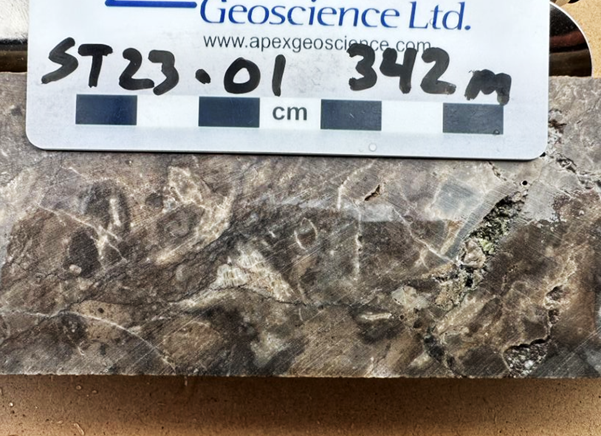
DRILL HOLE ST23-02 DETAILS
Drill hole ST23-02 was drilled to a downhole depth of 602m and intersected a continuous 37m thick zone of visual copper mineralization from 333m downhole (Figure 7).
The mineralized interval is variably brecciated and fractured with chalcocite as the dominant copper sulfide mineral. The lower section of the interval contains very strong mineralization with 1-5% visual sulfide and localized breccias containing up to 30% chalcocite. Rare native copper and sphalerite (zinc sulfide) along with pyrite are present within the lower part of the mineralized sequence.
The copper mineralization is hosted within bioturbated mudstones within a broader interval of fossiliferous carbonates. The geology and mineralization are very similar to drill holes ST23-01 and ST22-10 and located at a similar depth (Figure 7). Mineralization elsewhere at Storm is zoned (chalcocite - chalcopyrite - pyrite - sphalerite/galena), so the presence of chalcocite suggests that drill hole ST23-02 is potentially vectoring to the higher-grade portions of the copper system.
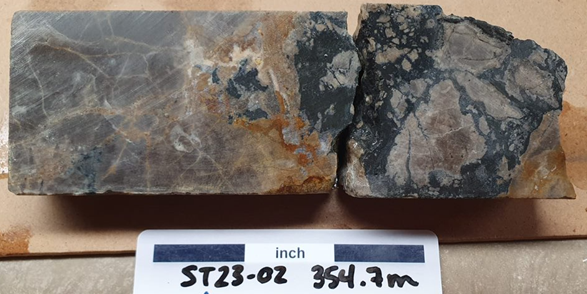
Hole ID | From (m) | To (m) | Min | Description |
ST23-02 | 0.0 | 47.5 | Cape Storm Formation | |
47.5 | 58 | Allen Bay Formation | ||
58 | 62 | cp, py | fine disseminated along fractures py/cp (0.1%) | |
62 | 78.5 | Dolomudstone | ||
78.5 | 109 | py | Trace and blebby pyrite (0.1%) | |
109 | 239 | Dolomudstone with rare pyrite | ||
239 | 239.5 | sph | Fault breccia with clay and anomalous zinc | |
239.5 | 310 | Dolomudstone | ||
310 | 322 | Crystalline dolowackestone | ||
322 | 333 | Coral floatstone with stromatolite | ||
333 | 353 | cc | Fractured/brecciated with trace cc (0.1%) | |
353 | 356 | cc, py | Breccia fill cc (1-2%) with thicker bands (30%) | |
356 | 357 | cc | Silty band with cc (2-5%), thicker bands (20%) | |
357 | 360 | cc, py | Breccia fill cc (1-2%) with thicker bands (30%) | |
360 | 370 | Cu, sph | Local floatstone with native Cu (1%) | |
370 | 381 | Muddy laminated limestone | ||
381 | 441 | Dolomudstone with occasional floatstone | ||
441 | 455 | py | Massive dolomudstone with py (0.1%) filled vugs | |
455 | 602 | Dolomudstone with occasional floatstone |
Table 3: Summary geological log for drill hole ST23-02. Mineralization key: cc = chalcocite, cp = chalcopyrite, br = bornite, py = pyrite, Cu = native copper, ct = cuprite, ml = malachite, sph = sphalerite, ga = galena. (5%) = visual estimation of sulfide content.
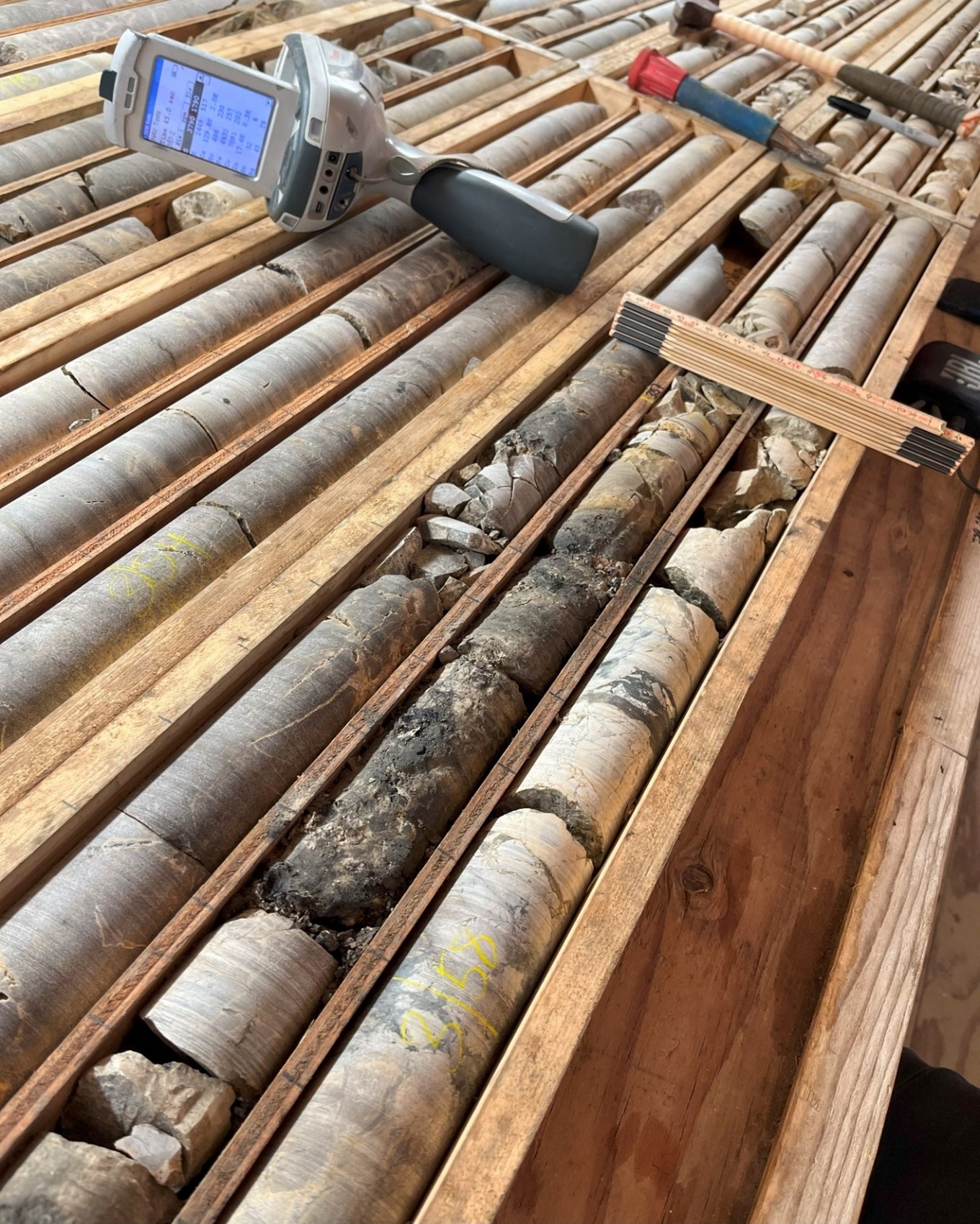
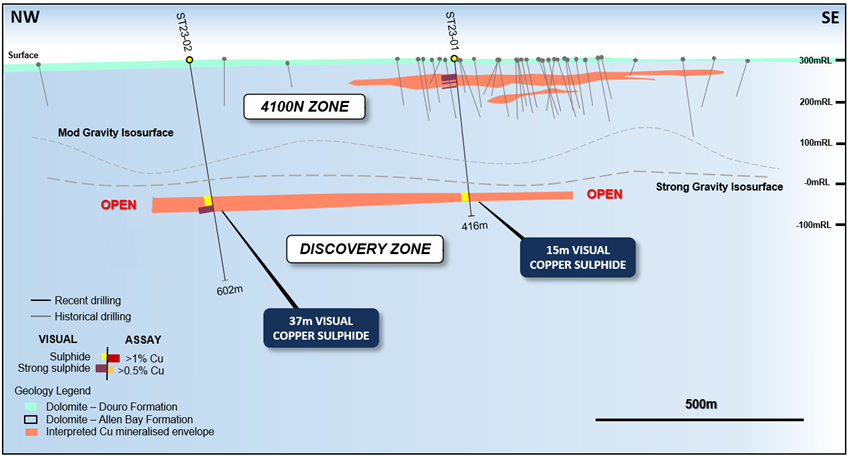


Figure 8: Map of the Storm and Tornado/Blizzard areas showing the ground gravity survey data over Storm (2023 survey) and Tornado/Blizzard (2015 survey), overlaying the property-scale airborne gravity gradiometry survey data (2017 Falcon Survey).
EXTENSIVE COPPER SYSTEM AT STORM
The copper mineralization and geology within drill holes ST23-01, ST23-02 and ST22-10 are highly similar and suggest that the stratigraphy of the mineralized system is laterally very extensive. The geometry of the host package is interpreted to be relatively flat-lying and predictable, with thick sequences of altered sediments comprised of dolomudstone and carbonate rocks.
The geology of the mineralized sequence displays all the elements required in the sediment-hosted mineralization process which include permeable carbonate rocks to act as a fluid conduit and host to mineralization, hydrocarbons to reduce metal-bearing fluids and force metal precipitation, a sulfur source from bitumen and sour gas, and a favourable structural setting to act as a plumbing system for metal-bearing fluids.
The metal and minerals show distinct zonation with a large copper-rich core (chalcocite, bornite and covellite) that gives way laterally and vertically to thinner peripheral zones of copper-iron (chalcopyrite), iron (pyrite), zinc (sphalerite) and minor lead (galena).
The Storm area shows clear similarities to many of the world's major sediment-hosted copper systems, including the deposits of the Kalahari Copper Belt (Botswana) and Central African Copper Belt (DRC, Zambia). These copper deposits typically have metre scale thicknesses and kilometre scale strikes of the mineralized zones.
A series of extensive gravity, EM and IP anomalies have been defined underneath the near-surface copper mineralization in the Storm area. The three drill holes completed to date targeted only one of the gravity features, with most of the larger system remaining untested. These gravity targets cover an area of over 7.5 km2, giving significant potential for the Storm area to host a world-class scale copper system.
The regional potential continues outside of the Storm area, with airborne gravity targets (Falcon Survey) that can be traced over 10km to the east along the graben and into the Tornado/Blizzard Prospects, where copper is exposed at the surface (Figure 8).

PLANNED PROGRAM
- The diamond drilling continues to test key geophysical and geological copper targets in the Storm area. The third exploration drill hole is underway and is collared approximately 1.7km south of ST23-02, and 1km west of the high-grade 2750N Zone. The hole is testing a large gravity anomaly and EM conductor in an area with limited previous drilling. Initial assays for the diamond drilling are expected in the next 4 weeks.
- The Reserve Circulation (RC) drilling is continuing in the Storm area with the results from the 2750N and 2200N Zones expected shortly. Drilling will also focus on expansion of the 4100N Zone and testing several new, near-surface copper targets. Initial assays are expected in the next 2-3 weeks.
- Sorting, beneficiation and process optimization continues on a range of mineralization styles.
- An environmental baseline survey will begin in mid-August 2023.

About the Storm Copper and Seal Zinc-Silver Projects, Nunavut
The Nunavut property consists of 173 contiguous mining claims covering an area of approximately 219,257 hectares on Somerset Island, Nunavut, Canada. The Storm Project comprises both the Storm Copper Project, a high-grade sediment-hosted copper discovery (intersections including 110m* @ 2.45% Cu from surface and 56.3m* @ 3.07% Cu from 12.2m) as well as the Seal Zinc Deposit (intersections including 14.4m* @ 10.58% Zn, 28.7g/t Ag from 51.8m and 22.3m* @ 23% Zn, 5.1g/t Ag from 101.5m). Additionally, there are numerous underexplored and undrilled targets within the 120-kilometre strike length of the mineralized trend, including the Tornado copper prospect where 10 grab samples yielded >1% Cu up to 32% Cu in gossans.
Storm Discovery and Historical Work
High-grade copper mineralization was discovered at Storm in the mid-1990s by Cominco geologists conducting regional zinc exploration around their then-producing Polaris lead-zinc mine. A massive chalcocite boulder found in a tributary of the Aston River in 1996 was traced to impressive surface exposures of broken chalcocite mineralization at the surface for hundreds of metres strike length at what became named the 2750N, 2200N, and 3500N Zones. Subsequent seasons of prospecting, geophysics and over 9,000 m of drilling into the early 2000s confirmed a significant amount of copper mineralization below the surface exposures as well as making the blind discovery of the 4100N Zone, a large area of copper mineralization with no surface exposure.
Following the merger of Cominco with Teck in 2001 and the closure of the Polaris Mine, the Storm claims were allowed to lapse in 2007. Commander Resources re-staked the property in 2008 and flew a helicopter-borne VTEM survey in 2011 but conducted no additional drilling. Aston Bay subsequently entered into an earn-in agreement with Commander and consolidated 100% ownership in 2015. Commander retains a 0.875% Gross Overriding Royalty in the area of the original Storm claims.
In 2016 Aston Bay entered into an earn-in agreement with BHP, who conducted a 2,000-station soil sampling program and drilled 1,951m of core in 12 diamond drill holes, yielding up to 16m* @ 3.1% Cu. BHP exited the agreement in 2017. Aston Bay conducted a property-wide airborne gravity gradiometry survey in 2017 and drilled 2,913m in nine core holes in the Storm area in 2018 yielding a best intercept of 1.5m* @ 4.39% Cu and 20.5m* @ 0.56% Cu.
Agreement with American West Metals
An earn-in agreement for the Storm and Seal properties was signed with American West Metals in March 2021. Under the terms of the agreement, an expenditure of C$10m will earn 80% ownership of the property for American West. Aston Bay is carried for all expenditures to the completion of a feasibility study and production decision. If Aston Bay chooses not to participate and is diluted below 10% ownership, the ownership converts to a 2% Net Smelter Royalty, half of which is purchasable by American West for C$5m at first production. Aston Bay received a cash payment of C$500,000 on signing.
Recent Work
American West completed a fixed loop electromagnetic (FLEM) ground geophysical survey in 2021 that yielded several new subsurface conductive anomalies. A total of 1,534m were drilled in 10 diamond drill holes in the 2022 season, yielding several impressive near-surface intercepts including 41m* @ 4.1% Cu as well as 68m of sulfide mineralization associated with a deeper conductive anomaly.
In April 2022 results of beneficiation studies demonstrated that a mineralized intercept grading 4% Cu from the 4100N area could be upgraded to a 54% Cu direct ship product using standard sorting technology. Further beneficiation studies are ongoing.
In April 2023 American West embarked on a spring delineation drilling program using a helicopter-portable reverse circulation (RC) drill rig as well as gravity and moving loop electromagnetic (MLEM) ground geophysical programs. Results from the programs are in process and are released as they come available.
A summer 2023 program plans further delineation drilling of the near-surface high-grade copper zones to advance them toward maiden resource reports by late 2023. Diamond drilling is planned to test new high-priority gravity targets and environmental baseline studies will be initiated.
*Stated drill hole intersections are all core length, and true width is expected to be 60% to 95% of core length.
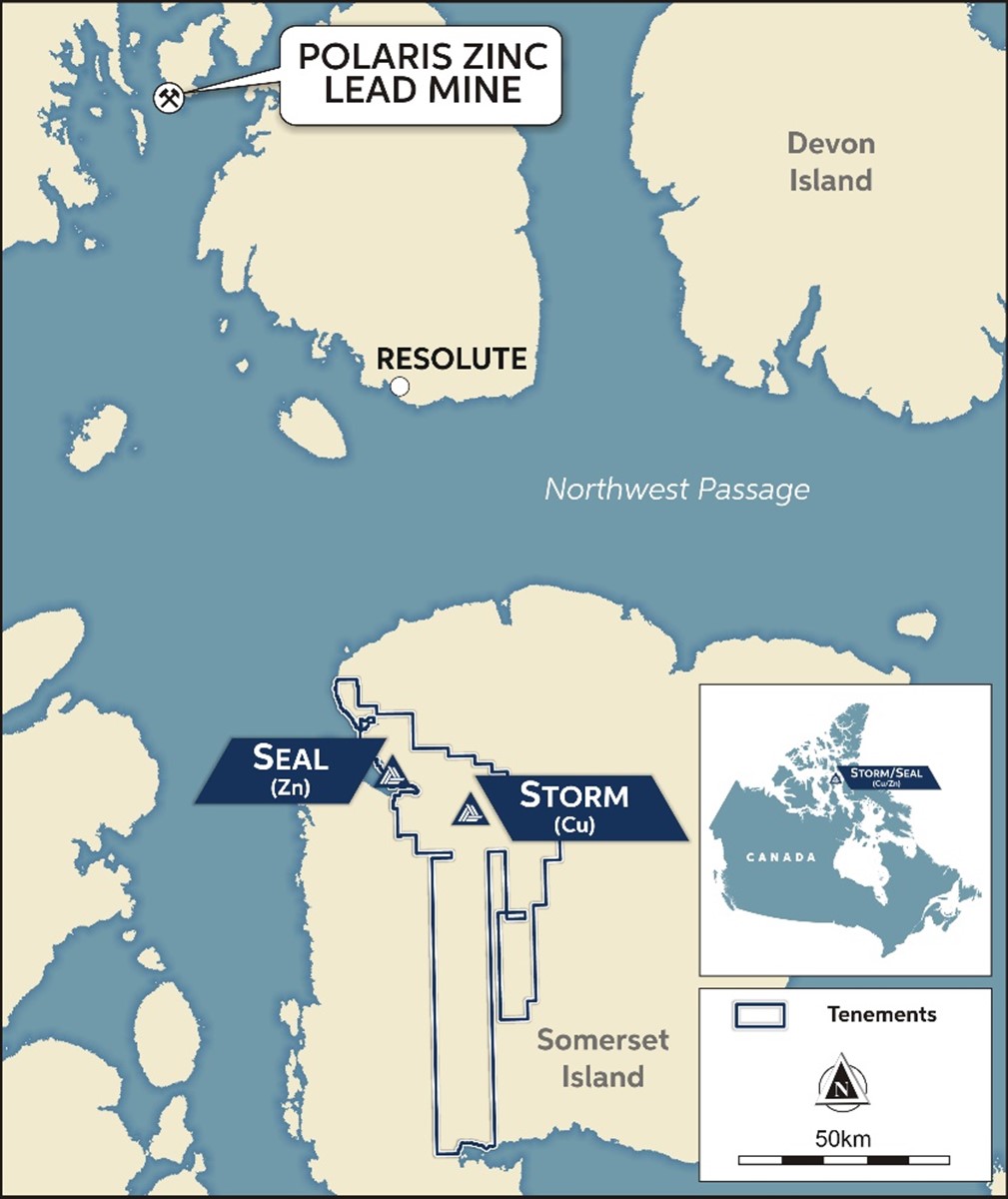
QA/QC Protocols
The analytical work reported herein was performed by ALS Global ("ALS"), Vancouver Canada. ALS is an ISO-IEC 17025:2017 and ISO 9001:2015 accredited geoanalytical laboratory and is independent of Aston Bay Holdings Ltd., American West Metals Limited, and the QP. Reverse Circulation drilling was completed by Northspan Explorations Ltd using a Hornet helicopter-portable drilling rig. The sampling interval for reverse circulation drilling is five feet, with sampling and geological intervals determined visually by geologists with relevant experience. Samples were subject to crushing at a minimum of 70% passing 2 mm, followed by pulverizing of a 250-gram split to 85% passing 75 microns. Samples were subject to 33 element geochemistry by four-acid digestion and inductively coupled plasma atomic emission spectroscopy (ICP-AES) to determine concentrations of copper, silver, lead, zinc, and other elements (ALS Method ME-ICP61a). Overlimit values for copper (>10%) and were analyzed via four-acid digestion and ICP-AES (ALS Method Cu-OG62).
Aston Bay Holdings Ltd. and American West Metals Limited followed industry standard procedures for the work carried out on the Storm Project, incorporating a quality assurance/quality control (QA/QC) program. Blank, duplicate, and standard samples were inserted into the sample sequence and sent to the laboratory for analysis. No significant QA/QC issues were detected during review of the data. Aston Bay Holdings Ltd. and American West Metals Limited are not aware of any drilling, sampling, recovery, or other factors that could materially affect the accuracy or reliability of the data referred to herein.
Qualified Person
Michael Dufresne, M.Sc., P.Geol., P.Geo., is a qualified person as defined by National Instrument 43-101 and has reviewed and approved the scientific and technical information in this press release.
About Aston Bay Holdings
Aston Bay is a publicly traded mineral exploration company exploring for high-grade copper and gold deposits in Virginia, USA, and Nunavut, Canada. The Company is led by CEO Thomas Ullrich with exploration in Virginia directed by the Company's advisor, Don Taylor, the 2018 Thayer Lindsley Award winner for his discovery of the Taylor Pb-Zn-Ag Deposit in Arizona. The Company is currently exploring the high-grade Buckingham Gold Vein in central Virginia and is in advanced stages of negotiation on other lands with high-grade copper potential in the area.
The Company is 100% owner of the Storm Project property, which hosts the Storm Copper Project and the Seal Zinc Deposit and has been optioned to American West Metals Limited.
About American West Metals Limited
AMERICAN WEST METALS LIMITED (ASX: AW1) is an Australian clean energy mining company focused on growth through the discovery and development of major base metal mineral deposits in Tier 1 jurisdictions of North America. Our strategy is focused on developing mines that have a low-footprint and support the global energy transformation. Our portfolio of copper and zinc projects in Utah and Canada include significant existing resource inventories and high-grade mineralization that can generate robust mining proposals. Core to our approach is our commitment to the ethical extraction and processing of minerals and making a meaningful contribution to the communities where our projects are located.
Led by a highly experienced leadership team, our strategic initiatives lay the foundation for a sustainable business which aims to deliver high-multiplier returns on shareholder investment and economic benefits to all stakeholders.
For further information on American West, visit: www.americanwestmetals.com.
FORWARD-LOOKING STATEMENTS
Statements made in this news release, including those regarding the Option Agreement, grant of the Option and the expected closing date, American West's interest in the Storm Project and its other acquisitions and plans, plans for the upcoming field season, management objectives, forecasts, estimates, expectations, or predictions of the future may constitute "forward-looking statement", which can be identified by the use of conditional or future tenses or by the use of such verbs as "believe", "expect", "may", "will", "should", "estimate", "anticipate", "project", "plan", and words of similar import, including variations thereof and negative forms. This press release contains forward-looking statements that reflect, as of the date of this press release, Aston Bay's expectations, estimates and projections about its operations, the mining industry and the economic environment in which it operates. Statements in this press release that are not supported by historical fact are forward-looking statements, meaning they involve risk, uncertainty and other factors that could cause actual results to differ materially from those expressed or implied by such forward-looking statements. Although Aston Bay believes that the assumptions inherent in the forward-looking statements are reasonable, undue reliance should not be placed on these statements, which apply only at the time of writing of this press release. Aston Bay disclaims any intention or obligation to update or revise any forward-looking statement, whether as a result of new information, future events or otherwise, except to the extent required by securities legislation.
For more information contact:
Thomas Ullrich, Chief Executive Officer
thomas.ullrich@astonbayholdings.com
(416) 456-3516
Sofia Harquail, IR and Corporate Development
sofia.harquail@astonbayholdings.com
(647) 821-1337
SOURCE: Aston Bay Holdings Ltd
View source version on accesswire.com:
https://www.accesswire.com/771681/Aston-Bay-and-American-West-Metals-Announce-Major-Copper-Discovery-at-the-Storm-Copper-Project-Canada

